1989–2019: Politics of Space in the New Berlin
12 Sep - 13 Oct 2019
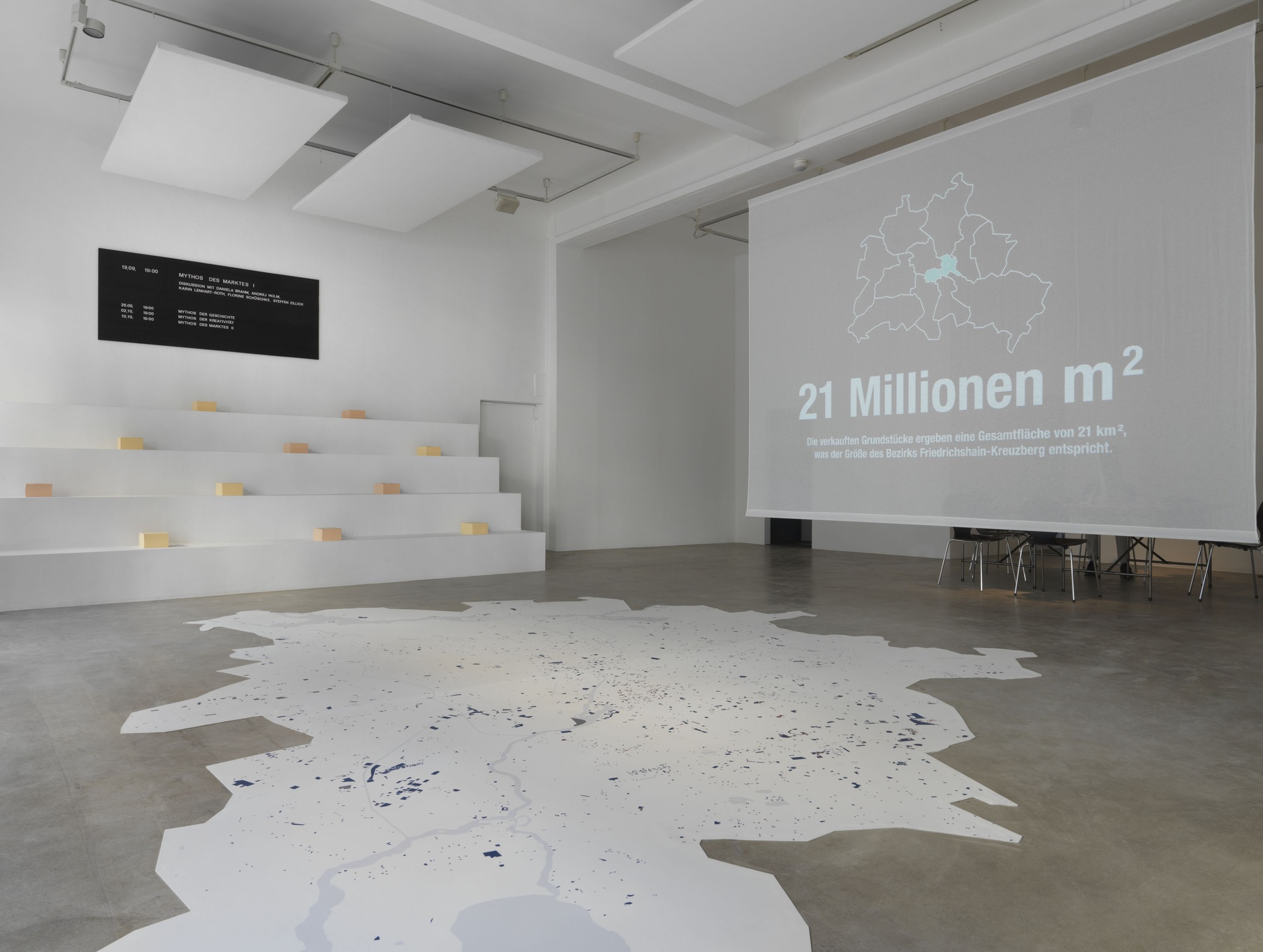
1989–2019: Politics of Space in the New Berlin, exhibition view Neuer Berliner Kunstverein, 2019: exhibition architecture by ARCH+ in cooperation with Peter Grundmann; Glossary of Privatization by Andrej Holm, 26 tear-off pads, 1,000 sheets each; Cartography of Privatization by Florine Schüschke, color print on vinyl, projection on gauze © Neuer Berliner Kunstverein / Jens Ziehe
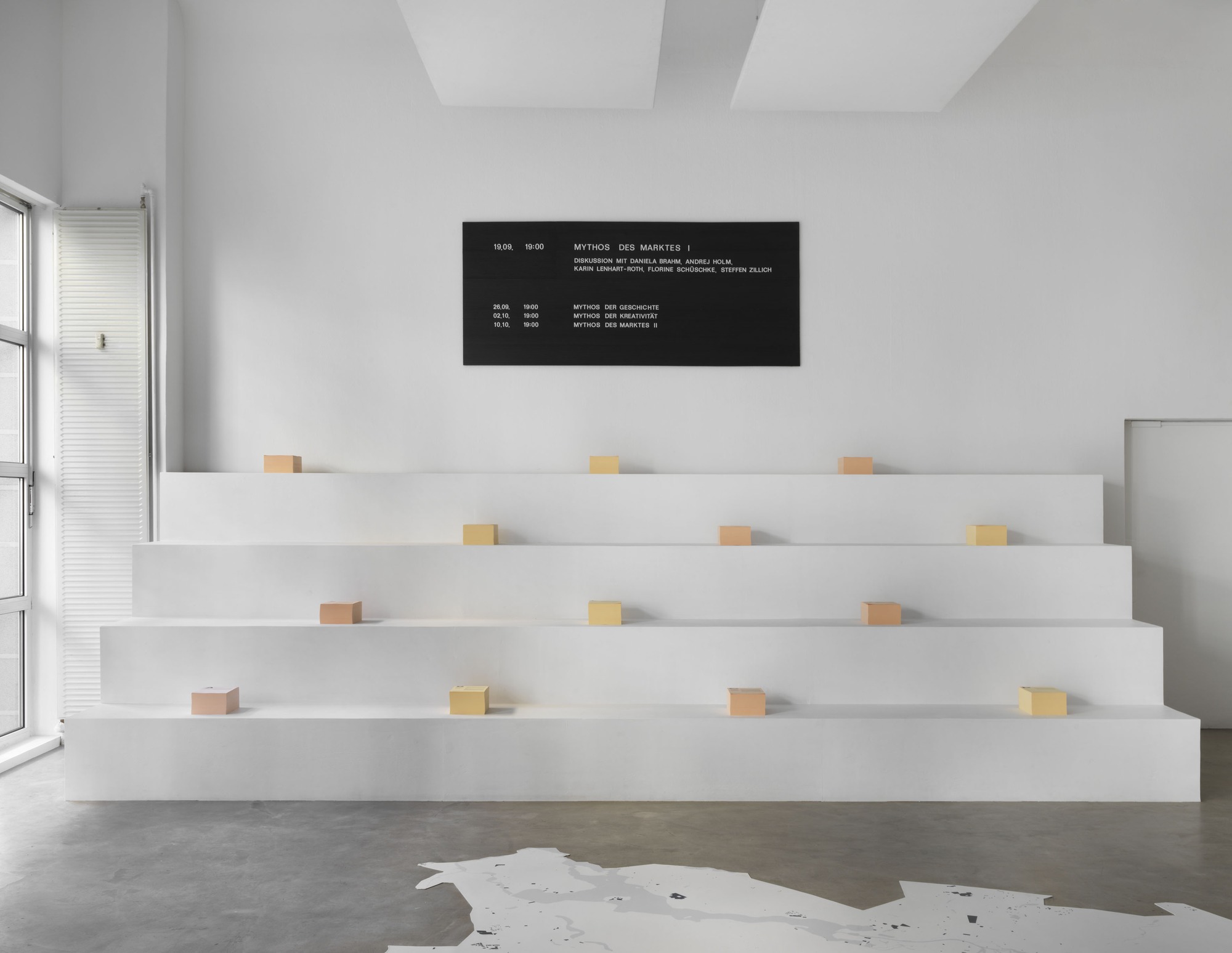
1989–2019: Politics of Space in the New Berlin, exhibition view Neuer Berliner Kunstverein, 2019: exhibition architecture by ARCH+ in cooperation with Peter Grundmann; Glossary of Privatization by Andrej Holm, 26 tear-off pads, 1,000 sheets each; Cartography of Privatization by Florine Schüschke, color print on vinyl, projection on gauze © Neuer Berliner Kunstverein / Jens Ziehe
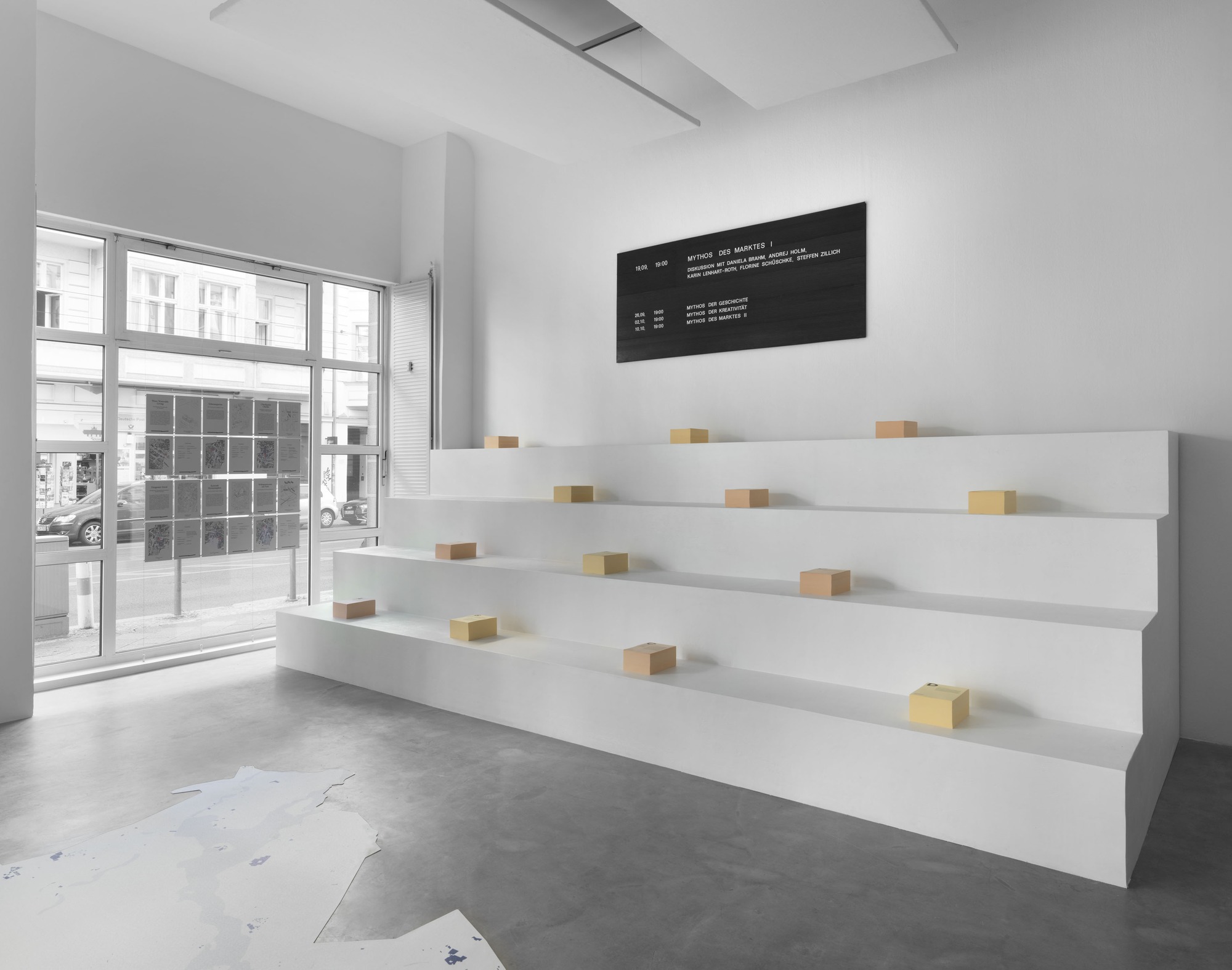
1989–2019: Politics of Space in the New Berlin, exhibition view Neuer Berliner Kunstverein, 2019. Exhibition architecture by ARCH+ in cooperation with Peter Grundmann; Glossary of Privatization by Andrej Holm, 26 tear-off pads, 1,000 sheets each; Real Estate of Emergency Charlotte Malterre-Barthes and students of the TU Berlin, forex print, 48 panels. Cartography of Privatization by Florine Schüschke, color print on vinyl. © Neuer Berliner Kunstverein / Jens Ziehe
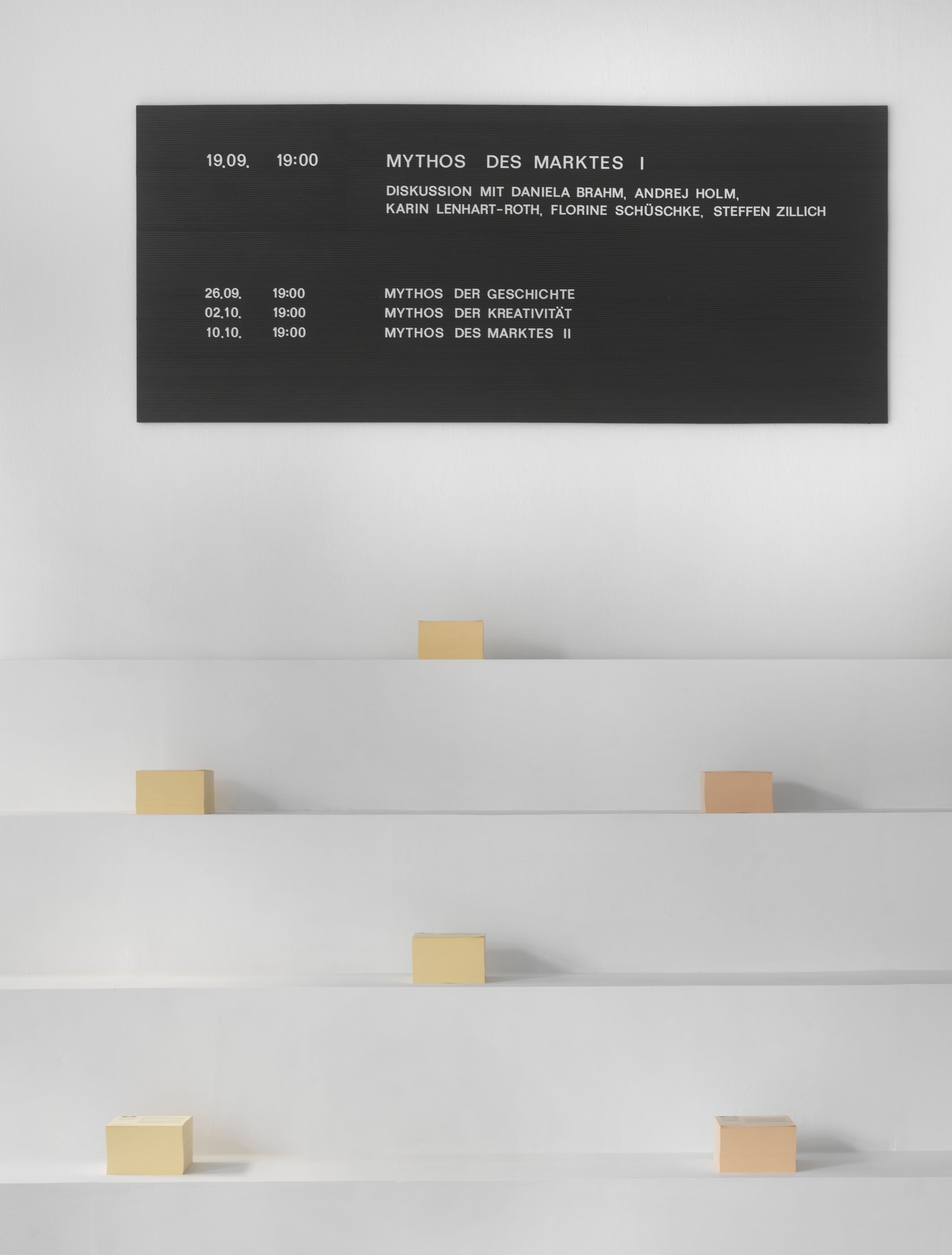
1989–2019: Politics of Space in the New Berlin, exhibition view Neuer Berliner Kunstverein, 2019. Exhibition architecture by ARCH+ in cooperation with Peter Grundmann; Glossary of Privatization by Andrej Holm, 26 tear-off pads, 1,000 sheets each; © Neuer Berliner Kunstverein / Jens Ziehe
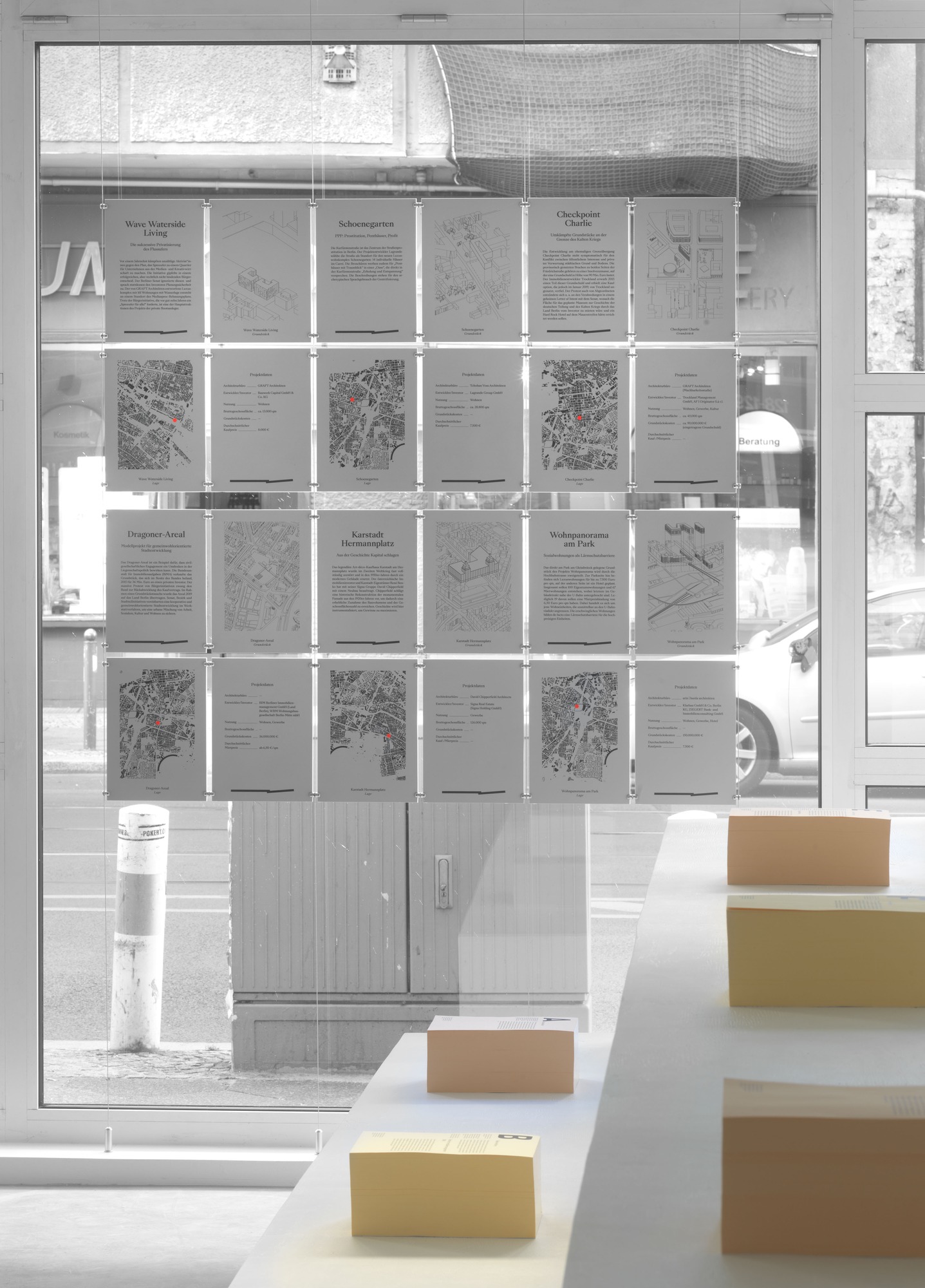
1989–2019: Politics of Space in the New Berlin, exhibition view Neuer Berliner Kunstverein, 2019. Exhibition architecture by ARCH+ in cooperation with Peter Grundmann; Glossary of Privatization by Andrej Holm, 26 tear-off pads, 1,000 sheets each; Real Estate of Emergency Charlotte Malterre-Barthes and students of the TU Berlin, forex print, 48 panels. © Neuer Berliner Kunstverein / Jens Ziehe
Staging Berlin as a cultural hub in the wake of the Berlin banking crisis is an expression of a new urban policy that seeks to inflate the myth of the creative Berlin and establish the city as a global place of longing by means of the targeted valorization of subcultures and countercultures. The exhibition 1989-2019: Politics of Space in the New Berlin outlines the urbanistic and architectural development from the point of view of the supposed “end of history”: How did Berlin become what it is today? Here, the aim is not to achieve completeness in the sense of linear historiography, but to depict partly contradictory processes and narratives that to this day are superimposing and intensifying in Berlin as a constructed city. There is not only one Berlin, but many myths and ideas of what Berlin is supposed to be. The exhibition reflects the perspectives and myths of history, of the market and of creativity.
With works by Guerilla Architects in cooperation with Philine Schneider and Shahrzad Rahmani, Verena Hartbaum, Andrej Holm, Charlotte Malterre-Barthes (with students from Technische Universität Berlin), Daniel Poller, Schroeter & Berger, Florine Schüschke
- - -
With works by Guerilla Architects in cooperation with Philine Schneider and Shahrzad Rahmani, Verena
Hartbaum, Andrej Holm, Charlotte Malterre-Barthes (with students from Technische Universität Berlin),
Daniel Poller, Schroeter & Berger, Florine Schüschke
Artistic directors: Marius Babias, Anh-Linh Ngo
Curatorial team: Frederick Coulomb, Nora Dünser, Mirko Gatti, Dorothee Hahn, Christian Hiller, Max
Kaldenhoff
Project management: Max Kaldenhoff, Arkadij Koscheew
Project coordination: Krisztina Hunya, Christine Rüb
Exhibition architecture: ARCH+ in cooperation with Peter Grundmann
The press preview takes place on the occasion of the Berlin Art Week press tour,
the curators will be present, the date will be announced shortly.
The end of the bloc confrontation between East and West, heralded by the fall of the Berlin Wall – a turning
point that prompted the political scientist Francis Fukuyama to speak of the “end of history” – had quite
particular consequences for the urban development in Berlin, where geographically the capitalist and the
real-socialist world orders directly collided. On the one hand, new political and cultural spaces were opened
up; on the other, the fall of the Berlin Wall paved the way for the neo-liberalization of politics. The political
intent for reforms was justified by the need to be able to compete with other metropolises. The new spatial
policy took place on three levels: Far-reaching administrative reforms made it possible to sell municipal real
estate all across the city, and today, the long-term consequences are increasingly putting the housing market
and the socio-spatial fabric of the city under pressure. On the architectural level, Berlin Neo-historicism
met the need for national identity, but the 1990s debate about architectural reconstruction functioned as an
ideological disguise and obscured the aforementioned transformation processes.
Staging Berlin as a cultural hub in the wake of the Berlin banking crisis is an expression of a new urban
policy that seeks to inflate the myth of the creative Berlin and establish the city as a global place of longing
by means of the targeted valorization of subcultures and countercultures. The exhibition 1989-2019:
Politics of Space in the New Berlin outlines the urbanistic and architectural development from the point of
view of the supposed “end of history”: How did Berlin become what it is today? Here, the aim is not to
achieve completeness in the sense of linear historiography, but to depict partly contradictory processes and
narratives that to this day are superimposing and intensifying in Berlin as a constructed city. There is not
only one Berlin, but many myths and ideas of what Berlin is supposed to be. The exhibition reflects the
perspectives and myths of history, of the market and of creativity.
The exhibition 1989-2019: Politics of Space in the New Berlin
Projects realized especially for the exhibition exemplify various urbanistic policies and their consequences
for today’s Berlin. A comprehensive mapping of the privatization of Berlin for the first time visualizes
the sale of municipal real estate throughout the past decades. In his Glossar der Privatisierung (Glossary
of Privatization), Andrej Holm analyses certain terms that reflect administrative instruments and processes
on the basis of which the extensive sale of state-owned real estate was executed. Charlotte Malterre-
Barthes and students of the Technical University of Berlin present the real estate portfolio Real Estate of
Emergency, which examines around thirty current objects of speculation and exposes the interests behind
them. Guerilla Architects examine the language of the speculative housing market by translating a glossary
of the real estate language into film. Schroeter & Berger deal with the creativity dispositif of the
municipal marketing campaign be Berlin and adapt its aesthetics by means of collage, montage and détournement.
Based on a research project by architectural theoretician Verena Hartbaum, who systematically
explored Berlin’s historicizing architecture, Daniel Poller recorded the vast number of new buildings
of the last three decades in a photo documentation in order to demonstrate social mechanisms of distinction
and exclusion on the basis of their formal principles. With his video installation, Poller creates the
image of a real existing Berlin that has chosen the past as its social objective.
Public editorial office
ARCH+ is an independent magazine for architecture and urbanism. Founded in the wake of the 1968
awakening, it focuses on the critical reflection of the social aspirations of architecture. Each issue gives
an in-depth examination of a topic and addresses current discussions in other disciplines with regard to
architectural and urbanistic issues. For the time of the exhibition, ARCH+ will relocate its editorial offices
to Neuer Berliner Kunstverein in order to create an issue, based on the exhibition and the discourse
program, that seeks to address the discursive and political changes of recent times as well as the current
paradigm of the spatial policy in Berlin. As already realized during documenta 12 (2007), ARCH+ transforms
an exhibition space into a public editorial office and combines artistic positions with the production
of critical theory.
Discourse program
Selective glimpses into the history, present and future of the city are supposed to sound out what the
urban Berlin consists of today. Politicians, architects, urban theorists, artists and activists will be discussing
the politics of space in the New Berlin: What to do about historically amnesiac ambitions? What is
the current constitution of urban social movements, how can their relationship to party politics be apprehended
in terms of emancipation? What kind of associations, planning approaches and architectures are
needed to create a Berlin that is open and based on solidarity?
Artistic directors: Marius Babias, Anh-Linh Ngo
Curatorial team: Frederick Coulomb, Nora Dünser, Mirko Gatti, Dorothee Hahn, Christian Hiller, Max
Kaldenhoff
Project management: Max Kaldenhoff, Arkadij Koscheew
Project coordination: Krisztina Hunya, Christine Rüb
Exhibition architecture: ARCH+ in cooperation with Peter Grundmann
With works by Guerilla Architects in cooperation with Philine Schneider and Shahrzad Rahmani, Verena Hartbaum, Andrej Holm, Charlotte Malterre-Barthes (with students from Technische Universität Berlin), Daniel Poller, Schroeter & Berger, Florine Schüschke
- - -
With works by Guerilla Architects in cooperation with Philine Schneider and Shahrzad Rahmani, Verena
Hartbaum, Andrej Holm, Charlotte Malterre-Barthes (with students from Technische Universität Berlin),
Daniel Poller, Schroeter & Berger, Florine Schüschke
Artistic directors: Marius Babias, Anh-Linh Ngo
Curatorial team: Frederick Coulomb, Nora Dünser, Mirko Gatti, Dorothee Hahn, Christian Hiller, Max
Kaldenhoff
Project management: Max Kaldenhoff, Arkadij Koscheew
Project coordination: Krisztina Hunya, Christine Rüb
Exhibition architecture: ARCH+ in cooperation with Peter Grundmann
The press preview takes place on the occasion of the Berlin Art Week press tour,
the curators will be present, the date will be announced shortly.
The end of the bloc confrontation between East and West, heralded by the fall of the Berlin Wall – a turning
point that prompted the political scientist Francis Fukuyama to speak of the “end of history” – had quite
particular consequences for the urban development in Berlin, where geographically the capitalist and the
real-socialist world orders directly collided. On the one hand, new political and cultural spaces were opened
up; on the other, the fall of the Berlin Wall paved the way for the neo-liberalization of politics. The political
intent for reforms was justified by the need to be able to compete with other metropolises. The new spatial
policy took place on three levels: Far-reaching administrative reforms made it possible to sell municipal real
estate all across the city, and today, the long-term consequences are increasingly putting the housing market
and the socio-spatial fabric of the city under pressure. On the architectural level, Berlin Neo-historicism
met the need for national identity, but the 1990s debate about architectural reconstruction functioned as an
ideological disguise and obscured the aforementioned transformation processes.
Staging Berlin as a cultural hub in the wake of the Berlin banking crisis is an expression of a new urban
policy that seeks to inflate the myth of the creative Berlin and establish the city as a global place of longing
by means of the targeted valorization of subcultures and countercultures. The exhibition 1989-2019:
Politics of Space in the New Berlin outlines the urbanistic and architectural development from the point of
view of the supposed “end of history”: How did Berlin become what it is today? Here, the aim is not to
achieve completeness in the sense of linear historiography, but to depict partly contradictory processes and
narratives that to this day are superimposing and intensifying in Berlin as a constructed city. There is not
only one Berlin, but many myths and ideas of what Berlin is supposed to be. The exhibition reflects the
perspectives and myths of history, of the market and of creativity.
The exhibition 1989-2019: Politics of Space in the New Berlin
Projects realized especially for the exhibition exemplify various urbanistic policies and their consequences
for today’s Berlin. A comprehensive mapping of the privatization of Berlin for the first time visualizes
the sale of municipal real estate throughout the past decades. In his Glossar der Privatisierung (Glossary
of Privatization), Andrej Holm analyses certain terms that reflect administrative instruments and processes
on the basis of which the extensive sale of state-owned real estate was executed. Charlotte Malterre-
Barthes and students of the Technical University of Berlin present the real estate portfolio Real Estate of
Emergency, which examines around thirty current objects of speculation and exposes the interests behind
them. Guerilla Architects examine the language of the speculative housing market by translating a glossary
of the real estate language into film. Schroeter & Berger deal with the creativity dispositif of the
municipal marketing campaign be Berlin and adapt its aesthetics by means of collage, montage and détournement.
Based on a research project by architectural theoretician Verena Hartbaum, who systematically
explored Berlin’s historicizing architecture, Daniel Poller recorded the vast number of new buildings
of the last three decades in a photo documentation in order to demonstrate social mechanisms of distinction
and exclusion on the basis of their formal principles. With his video installation, Poller creates the
image of a real existing Berlin that has chosen the past as its social objective.
Public editorial office
ARCH+ is an independent magazine for architecture and urbanism. Founded in the wake of the 1968
awakening, it focuses on the critical reflection of the social aspirations of architecture. Each issue gives
an in-depth examination of a topic and addresses current discussions in other disciplines with regard to
architectural and urbanistic issues. For the time of the exhibition, ARCH+ will relocate its editorial offices
to Neuer Berliner Kunstverein in order to create an issue, based on the exhibition and the discourse
program, that seeks to address the discursive and political changes of recent times as well as the current
paradigm of the spatial policy in Berlin. As already realized during documenta 12 (2007), ARCH+ transforms
an exhibition space into a public editorial office and combines artistic positions with the production
of critical theory.
Discourse program
Selective glimpses into the history, present and future of the city are supposed to sound out what the
urban Berlin consists of today. Politicians, architects, urban theorists, artists and activists will be discussing
the politics of space in the New Berlin: What to do about historically amnesiac ambitions? What is
the current constitution of urban social movements, how can their relationship to party politics be apprehended
in terms of emancipation? What kind of associations, planning approaches and architectures are
needed to create a Berlin that is open and based on solidarity?
Artistic directors: Marius Babias, Anh-Linh Ngo
Curatorial team: Frederick Coulomb, Nora Dünser, Mirko Gatti, Dorothee Hahn, Christian Hiller, Max
Kaldenhoff
Project management: Max Kaldenhoff, Arkadij Koscheew
Project coordination: Krisztina Hunya, Christine Rüb
Exhibition architecture: ARCH+ in cooperation with Peter Grundmann
